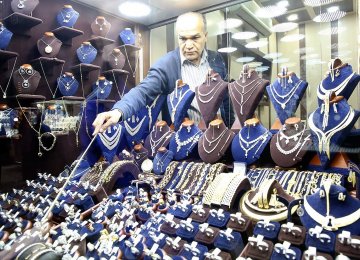Iran's gold jewelry demand in 2017 reached 45.4 tons, which was up 12% for the year and the most since 2013, data released by the World Gold Council show.
According to the council, Iran and Kuwait were the only Middle Eastern countries that registered higher gold jewelry demand last year.
Iran came close to beating Saudi Arabia, the region’s biggest buyer, which bought 45.7 tons of gold jewelry in 2017, down 8%, the report said.
Demand slowed in the fourth quarter, with a gain of 2%, as “worsening US-Iranian relations undermined consumer sentiment”, the council said.
Middle Eastern demand recovered in Q4, but H1 losses dominated as annual demand was down 1% YOY. Iran was also the strongest performer in 2017, with Q4 its 10th consecutive quarter showing YOY growth.
Elsewhere in the Middle East, appetite for gold jewelry has been lukewarm. Demand in the UAE sank to a 20-year low, the fourth consecutive annual decline.
In Egypt, demand was dented again by the weak local currency, which kept prices elevated. But in value terms, demand increased in 2017 (by 56% to reach E£15.8 million), suggesting that consumers consider a certain value of spend rather than focusing on the weight of gold they purchase.
In Turkey, record-high local prices weakened Q4 jewelry demand and put the brakes on annual growth. The gold price in Turkish lira terms jumped to record highs in late November, discouraging consumers from buying jewelry.
Meanwhile, Turkey’s Credit Guarantee Fund, which had injected the economy with a short-term liquidity boost, dried up. Economic uncertainty and political instability were further deterrents. But recycling activity was similarly subdued: In the uncertain environment, consumers preferred to stay on the sidelines.
On a global scale, demand for gold jewelry gained momentum in the final quarter of 2017, growing 3% YOY to a two-year high of 648.9 tons. A corresponding increase in full-year demand was primarily driven by recovery in India, the US and China.
These three markets together accounted for 78 tons of the 82-ton increase in global full-year demand.
In 2017, Europe saw a third consecutive annual decline in jewelry demand, with losses persistent throughout the year. The 3% drop in regional demand (from 76.1 tons to 74 tons) was largely due to weakness in the UK market, which remained troubled by Brexit concerns.






Add new comment
Read our comment policy before posting your viewpoints